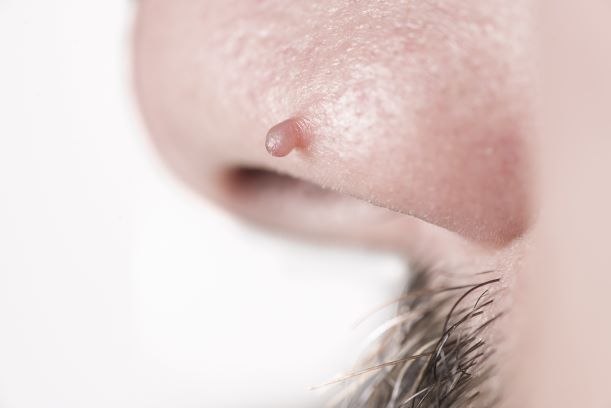Skin tags are a common concern that brings people to the dermatology office. While skin tags can be a nuisance, the good news is that they are not generally harmful to your health. According to Dr. Leon Chen of U.S. Dermatology Partners Medical District in Houston, Texas, “Skin tags aren’t harmful, but a large number of patients wish to get rid of them. Many patients try to remove their skin tags at home, but this can actually be more dangerous to your health than just living with them. It’s really important to talk to your dermatologist about professional skin tag removal if one or more of these bumps is bothering you.” In this blog, you can find out more about skin tags and available treatments for this skin condition.
What are Skin Tags?
The medical diagnostic name for skin tags is acrochordons. Skin tags are extremely common, benign skin growths. Almost 50% of adults will develop at least one skin tag. These growths are most likely to develop between the ages of 20 and 70, but children and seniors can also develop skin tags. While skin tags can appear in your twenties, they are more likely to appear as you age. Unlike many skin conditions that have a tendency to impact one gender more often than the other, skin tags are just as common for men and women.
Skin tags are soft growths that frequently develop in skin folds. Common parts of the body where skin tags develop include under the arms, around the neck, on the eyelids, in the groin, and under the breasts. However, they can form on any area of the body. In most cases, skin tags are the same shade as your natural skin tone, or they may have flesh-toned stalks with darker coloring on the end. Most skin tags are very small between 2 and 5 millimeters, but they can grow to between 1 and 3 centimeters over time. Typically, skin tags are not painful, but they can get caught or snag on clothes, jewelry, and other items, which can hurt. Additionally, skin tags with longer stalks can become twisted, leading to blood clots.
What Causes Skin Tags?
The cause of skin tags is not known. Many researchers and physicians believe that their development in folds of the skin suggests that they are produced by friction or repeated rubbing of skin against skin or external irritants (clothing, jewelry, etc.). While the exact cause of skin tags is not known, several risk factors increase the chances for skin tag development, including:
- Friction – rough clothing that rubs the skin, repetitive motion, irritation
- Weight – individuals who are overweight are more likely to develop skin tags
- Systemic illnesses – while it’s not fully supported, some researchers believe insulin resistance in diabetics may play a role
- Skin health concerns – some chronic skin conditions have been linked to the development of skin tags, specifically Birt-Hogg-Dube Syndrome
- Genes – those who have family members with skin tags seem to be more likely to develop them
- Aging – loss of skin firmness and elasticity as collagen and elastin production decreases may play a role
- Pregnancy – expectant mothers and individuals experiencing dramatic hormonal fluctuation often develop skin tags
Can You Prevent Skin Tag Development?
You can’t prevent skin tags from developing, but taking certain steps may reduce your chances of developing them. For example, you can wear soft fabrics and avoid repetitive movements. Stop wearing jewelry if you notice skin tags appearing in the area around the necklace or other item. You should also take care to maintain a healthy weight and keep diabetes and other systemic health conditions under control. These preventive measures can be especially important if you’re already genetically predisposed toward developing skin tags. According to Dr. Chen, “There is really no way to stop skin tags from forming, but if you are seeing a lot of them come up or they’re developing in one place, we may be able to help you determine the risk factor that’s leading to skin tag formation. Is a uniform rubbing under your arms, do you wear a necklace every day, did you recently gain weight? By making some changes, you may be able to reduce the number of skin tags that develop.”
What Treatment Options are Available?
According to Dr. Chen, “The good news is that skin tags are almost always benign growths, and they don’t have to be removed. If you do want to remove them, your dermatologist has a number of fast, comfortable treatment options.”
We may recommend removing skin tags in the following situations:
- One or more skin tags in a specific area are snagging on clothing, jewelry, and other items presenting a risk for the skin tag to be torn off or damaged.
- If skin tags are irritated causing discomfort, you may want to consider having them removed.
- If the appearance or location of skin tags bothers you, a dermatologist can remove the growth for cosmetic reasons.
- If you notice that your skin tag is firm, not the same color as surrounding skin or has multiple colors, is bleeding, or that it grows or changes rapidly, it may be a more serious skin condition. In these situations, your dermatologist will remove the skin tag and perform a biopsy to ensure it’s not cancerous.
If you decide to have a skin tag removed, your dermatologist can surgically excise the growth. We can also use heat (electrocautery) or cold (cryosurgery) to remove the skin tags. We may utilize a combination of surgical excision with heat or cold to stop bleeding and minimizing scarring.
Do I Need to Visit a Dermatologist for Removal, or Can I Remove Skin Tags at Home?
According to Dr. Chen, “Do it yourself ‘DIY’ projects like home renovations may be okay, but DIY skin tag removal can be dangerous. We know the internet is filled with how-to videos showing people removing their skin tags at home. It can be tempting to get on board, but no matter what you see on YouTube, skin tags should always be removed by a professional. Removing skin tags at home can cause a number of issues, including unnecessarily exposing yourself to infection risk.” In addition to infection, some other reasons you should not attempt to remove skin tags at home include:
- Bleeding – removing a skin tag on any part of the body can lead to bleeding that’s difficult to stop, especially since skin tags often appear on the neck where heavy bleeding is common. Additionally, these small growths can form over blood vessels, and removing them without proper training may cause you to nick a vein or capillary, leading to excessive blood loss.
- Cancer diagnosis – while skin tags are not typically cancerous or a symptom of skin cancer, they do require a professional diagnosis. What looks like a skin tag to you may actually be something more serious. You should always allow a professional to examine the skin tag and make an accurate diagnosis.
- Scars – properly removed, skin tags are unlikely to cause any scarring, but when skin tags are improperly removed, you are much more likely to see long term damage to the skin. Even if you’re not worried about the damage to your appearance, scarring can cause other issues, including limiting your range of motion.
Schedule an Appointment at U.S. Dermatology Partners
We are happy to now be welcoming non-emergency patients back into our dermatology practices, and if you’d like to schedule an appointment to remove one or more skin tags or discuss your treatment options, we’d love to hear from you. Get started by filling out our simple appointment request form. One of our local team members will be in touch soon to finalize your appointment details.
If you are a patient in a high-risk group for COVID-19 and would prefer to meet with one of our skilled dermatologists online, we are still offering teledermatology visits. You can complete a virtual visit request form on our website or contact your local U.S. Dermatology Partners practice to find out more. We’re here to help.
Find a location near me
or


